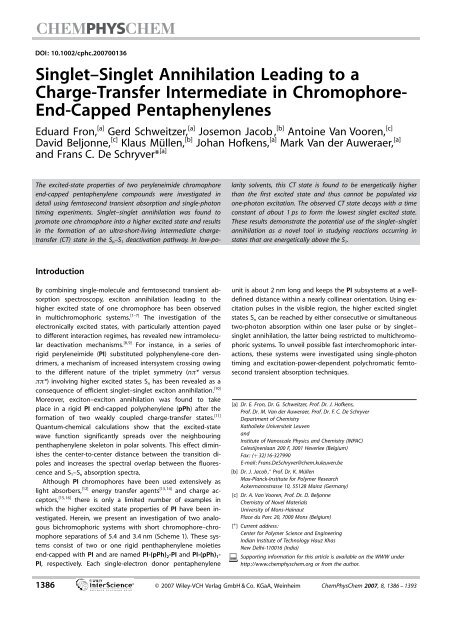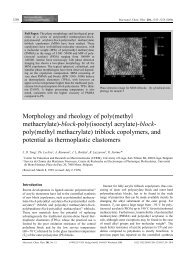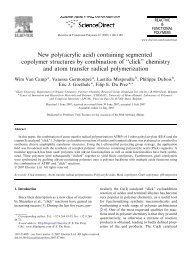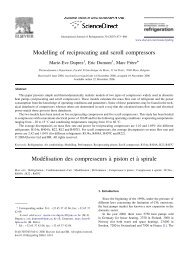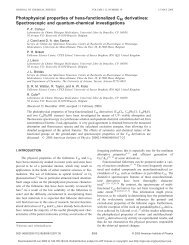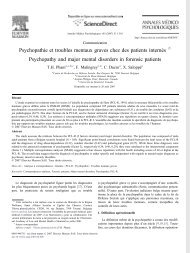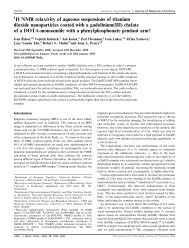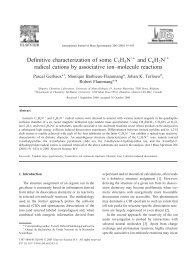Singlet-Singlet Annihilation Leading to a Charge-Transfer ...
Singlet-Singlet Annihilation Leading to a Charge-Transfer ...
Singlet-Singlet Annihilation Leading to a Charge-Transfer ...
You also want an ePaper? Increase the reach of your titles
YUMPU automatically turns print PDFs into web optimized ePapers that Google loves.
DOI: 10.1002/cphc.200700136<strong>Singlet</strong>–<strong>Singlet</strong> <strong>Annihilation</strong> <strong>Leading</strong> <strong>to</strong> a<strong>Charge</strong>-<strong>Transfer</strong> Intermediate in Chromophore-End-Capped PentaphenylenesEduard Fron, [a] Gerd Schweitzer, [a] Josemon Jacob , [b] An<strong>to</strong>ine Van Vooren, [c]David Beljonne, [c] Klaus Müllen, [b] Johan Hofkens, [a] Mark Van der Auweraer, [a]and Frans C. De Schryver* [a]The excited-state properties of two peryleneimide chromophoreend-capped pentaphenylene compounds were investigated indetail using fem<strong>to</strong>second transient absorption and single-pho<strong>to</strong>ntiming experiments. <strong>Singlet</strong>–singlet annihilation was found <strong>to</strong>promote one chromophore in<strong>to</strong> a higher excited state and resultsin the formation of an ultra-short-living intermediate chargetransfer(CT) state in the S n –S 1 deactivation pathway. In low-polaritysolvents,this CT state is found <strong>to</strong> be energeticallyhigherthan the first excited state and thus cannot be populated viaone-pho<strong>to</strong>n excitation. The observed CT state decays with a timeconstant of about 1 ps <strong>to</strong> form the lowest singlet excited state.These results demonstrate the potential use of the singlet–singletannihilation as a novel <strong>to</strong>ol in studying reactions occurring instates that are energeticallyabove the S 1 .IntroductionBy combining single-molecule and fem<strong>to</strong>second transient absorptionspectroscopy, exci<strong>to</strong>n annihilation leading <strong>to</strong> thehigher excited state of one chromophore has been observedin multichromophoric systems. [1–7] The investigation of theelectronically excited states, with particularly attention payed<strong>to</strong> different interaction regimes, has revealed new intramoleculardeactivation mechanisms. For instance, in a series of[8, 9]rigid peryleneimide (PI) substituted polyphenylene-core dendrimers,a mechanism of increased intersystem crossing owing<strong>to</strong> the different nature of the triplet symmetry (np* versuspp*) involving higher excited states S n has been revealed as aconsequence of efficient singlet–singlet exci<strong>to</strong>n annihilation. [10]Moreover, exci<strong>to</strong>n–exci<strong>to</strong>n annihilation was found <strong>to</strong> takeplace in a rigid PI end-capped polyphenylene (pPh) after theformation of two weakly coupled charge-transfer states. [11]Quantum-chemical calculations show that the excited-statewave function significantly spreads over the neighbouringpenthaphenylene skele<strong>to</strong>n in polar solvents. This effect diminishesthe center-<strong>to</strong>-center distance between the transition dipolesand increases the spectral overlap between the fluorescenceand S 1 –S n absorption spectra.Although PI chromophores have been used extensively aslight absorbers, [12] energy transfer agents [13,14] and charge accep<strong>to</strong>rs,[15,16] there is only a limited number of examples inwhich the higher excited state properties of PI have been investigated.Herein, we present an investigation of two analogousbichromophoric systems with short chromophore–chromophoreseparations of 5.4 and 3.4 nm (Scheme 1). These systemsconsist of two or one rigid penthaphenylene moietiesend-capped with PI and are named PI-(pPh) 2 -PI and PI-(pPh) 1 -PI, respectively. Each single-electron donor pentaphenyleneunit is about 2 nm long and keeps the PI subsystems at a welldefineddistance within a nearly collinear orientation. Using excitationpulses in the visible region, the higher excited singletstates S n can be reached by either consecutive or simultaneoustwo-pho<strong>to</strong>n absorption within one laser pulse or by singlet–singlet annihilation, the latter being restricted <strong>to</strong> multichromophoricsystems. To unveil possible fast interchromophoric interactions,these systems were investigated using single-pho<strong>to</strong>ntiming and excitation-power-dependent polychromatic fem<strong>to</strong>secondtransient absorption techniques.[a] Dr. E. Fron, Dr. G. Schweitzer, Prof. Dr. J. Hofkens,Prof. Dr. M. Van der Auweraer, Prof. Dr. F. C. De SchryverDepartment of ChemistryKatholieke Universiteit LeuvenandInstitute of Nanoscale Physics and Chemistry (INPAC)Celestijnenlaan 200 F, 3001 Heverlee (Belgium)Fax: (+ 32)16-327990E-mail: Frans.DeSchryver@chem.kuleuven.be[b] Dr. J. Jacob , + Prof. Dr. K. MüllenMax-Planck-Institute for Polymer ResearchAckermannstrasse 10, 55128 Mainz (Germany)[c] Dr. A. Van Vooren, Prof. Dr. D. BeljonneChemistryof Novel MaterialsUniversityof Mons-HainautPlace du Parc 20, 7000 Mons (Belgium)[ + ] Current address:Center for Polymer Science and EngineeringIndian Institute of TechnologyHauz KhasNew Delhi-110016 (India)Supporting information for this article is available on the WWW underhttp://www.chemphyschem.org or from the author.1386 2007 Wiley-VCH Verlag GmbH & Co. KGaA, Weinheim ChemPhysChem 2007, 8, 1386 – 1393
<strong>Singlet</strong>–<strong>Singlet</strong> <strong>Annihilation</strong>Scheme 1. Molecular structures of PI-(pPh) 1 -PI (1) and PI-(pPh) 2 -PI (2); R= n-octyl, Ar = 4-n-octylphenyl.Results and DiscussionSteady-State MeasurementsFigure 1 displays the normalised steady-state absorption andemission spectra of PI-(pPh) 1 -PI and PI-(pPh) 2 -PI in methylcyclohexane(MCH). The fluorescence quantum yields measuredin degassed conditions are compiled in Table 1. The extinctioncoefficient of the model compound PI-(pPh) 1 measured in <strong>to</strong>lueneis 52000 m 1 cm 1 at 515 nm.Both PI-(pPh) 1 -PI and PI-(pPh) 2 -PI have a large offset in theabsorption energy of the two constituents. The blue parts(350–450 nm) of their spectra originate from the dominantbackbone absorption (pPh units), whereas the bands centredat 520 nm are due <strong>to</strong> the S 0 –S 1 transition of the PI subsystem.While the features and positionof the lowest (S 0 !S 1 ) absorptionband of PI-(pPh) 1 , [17] PI-(pPh) 1 -PI and PI-(pPh) 2 -PI inMCH are nearly identical, the relativeintensity compared <strong>to</strong> tha<strong>to</strong>f the pPh band reflects theratio of PI and pPh units(Figure 1). The PI absorptionband appears slightly unstructuredwhen compared <strong>to</strong> theS 0 !S 1 of the phenyl-substitutedchromophore (C1P1), suggestingsome ground-state delocalisationover the neighbouring pPhunit. [15] Although the maximum and the vibronic structure ofthe absorption band attributed <strong>to</strong> the pPh moiety is situatedat the same wavelength for PI-(pPh) 1 -PI and its single-chromophoreanalogue PI-(pPh) 1 , this band is shifted over 20 nm <strong>to</strong>longer wavelength in PI-(pPh) 2 -PI. In addition, in PI-(pPh) 2 -PI,the fine structure is partially lost, suggesting increased conjugationbetween the pPh subsystems. In the emission spectrain MCH, the maxima (560 nm) and the vibronic shoulders aresimilar <strong>to</strong> previously studied PI-substituted pPh compounds.Again, the maximum and vibronic characteristics of the emissionspectra in MCH are only weakly shifted with respect <strong>to</strong>those of C1P1 in <strong>to</strong>luene. The loss of fine structure in the absorptionspectra and the persistence of the fine structure inthe emission spectra suggest an increased planarity of thepPh n moiety versus the PI moiety in the singlet excited state.We recently demonstrated that PI-(pPh) 1 dissolved in polarsolvents shows an efficient pho<strong>to</strong>induced charge transfer fromthe backbone <strong>to</strong> the end-cap; similar behaviour is expected forPI-(pPh) 1 -PI and PI-(pPh) 2 -PI. [17] The decrease of the quantumyield of the latter compounds in tetrahydrofuran (THF; see theSupporting Information, Table 1 for details) points <strong>to</strong> an improvedefficiency of the radiationless deactivation of the relaxedsinglet excited state. This effect is probably related <strong>to</strong>the dipolar character of the excited state suggested by a systematicredshift of the emission spectra with less pronouncedvibronic features in this solvent (see the Supporting Information,Figure 1 for details).Time-Resolved Experiments on PI-(pPh) 2 -PIFigure 1. Normalised absorption and emission spectra (excitation at 495 nm)of PI-(pPh) 1 -PI (b) and PI-(pPh) 2 -PI (c) in MCH.Table 1. Fluorescence quantum yields, absorption and emission maximaof the compounds PI-(pPh) 1 , PI-(pPh) 1 -PI and PI-(pPh) 2 -PI in MCH.Compound PI-(pPh) 1 PI-(pPh) 1 -PI PI-(pPh) 2 -PIQuantum yield 0.85 0.78 0.72Absorption maximum [nm] 510 515 512Emission maximum [nm] 560 560 562By single-pho<strong>to</strong>n-timing (SPT) experiments, the fluorescenceintensity of PI-(pPh) 2 -PI was found <strong>to</strong> decay monoexponentiallyover the entire wavelength range of the emission spectrumwith a time constant of 2.8 ns (3.5 ” 10 8 s 1 ). Combined withthe fluorescence quantum yield of 0.72, this decay yields a fluorescentrate constant of 2.5”10 8 s 1 . The slightly faster decaycompared <strong>to</strong> C1P1 (2.38 ” 10 8 s 1 , F=1 in <strong>to</strong>luene) at thesame emission maximum suggests a stronger transition dipolemoment. [15]Time-resolved transient absorption spectra obtained uponexcitation at 495 nm with two different excitation powers(60 mW and 400 mW) are depicted in Figure 2. The spectroscop-ChemPhysChem 2007, 8, 1386 – 1393 2007 Wiley-VCH Verlag GmbH & Co. KGaA, Weinheim www.chemphyschem.org 1387
F. C. De Schryver et al.ic features characteristic of PI can be recognised by the twobands rising instantaneously after excitation and decaying concurrentlyon a nanosecond time scale (see Figures 2 A and C).The negative part in the 500–550 nm region is due <strong>to</strong> groundstatedepletion mainly resembling the steady-state absorption,whereas the stronger negative band at 540–650 nm is associatedwith stimulated emission fully matching the stationaryemission spectra. The positive part (650–730 nm) with a molarextinction coefficient comparable <strong>to</strong> the value for the depletionband (when the ratio of the two signals is assessed) corresponds<strong>to</strong> the S 1 –S n absorption band within the PI chromophore.The transient spectrum between 540 nm and 750 nm isa sum of the excited-state absorption (positive contribution)and stimulated emission of the locally excited (LE) state (negativecontribution). [11] One should keep in mind that the excited-stateabsorption band might extend <strong>to</strong> lower wavelengthsthan the positive band, where it cancels <strong>to</strong> some the extentthe band due <strong>to</strong> induced emission. Therefore, in the calculationof the overlap with the fluorescence spectrum (seebelow), a correction for the stimulated emission componentthat affects this band had <strong>to</strong> be taken in<strong>to</strong> account.The important point is that a faster decay of these bands isclearly observed in the high-excitation-power experiments (seeFigures 2 C and D). By global kinetic analysis of these decaytraces (section across the wavelength axis—Figure 2 D) in addition<strong>to</strong> the component found in SPT, three extra decay-timecomponents were found: a component of (0.5–2) ps attributed<strong>to</strong> intramolecular vibrational redistribution (IVR), [12] a 4.2 pscomponent attributed <strong>to</strong> a vibrational relaxation (VR) processand another decay-time constant of 130 ps found[12, 18]only in the high-excitation-power experiments. Upon changingthe excitation power from 60 mW <strong>to</strong> 400 mW, the spectral amplitudeshape of both the 4.2 ps and 2.8 ns components remainsunaltered. When plotting the amplitude of the 130 pscomponent versus wavelength, the resulting shape exhibits anegative value in the 500–570 nm region and a positive valuein the red part of the spectrum at 620–730 nm (data notshown). Hence, the amplitude of this component resemblesthe spectral position of the ground-state depletion band andstimulated emission at short wavelengths and of the excitedstateabsorption band at long wavelengths. On the basis ofthe comparison with the kinetics of PI-(pPh) 1 and the powerFigure 2. Three-dimensional plot of the fem<strong>to</strong>second transient absorption spectra of PI-(pPh) 2 -PI in MCH recorded with excitation powers of 60 mW (A) and400 mW (C), and the time-resolved monochromatic transient absorption traces recorded in a 50 ps time window and the corresponding fits for the two excitationpowers 60 mW (B) and 400 mW (D); DOD is the change in optical density.1388 www.chemphyschem.org 2007 Wiley-VCH Verlag GmbH & Co. KGaA, Weinheim ChemPhysChem 2007, 8, 1386 – 1393
<strong>Singlet</strong>–<strong>Singlet</strong> <strong>Annihilation</strong>dependence described above, this 130 ps decay componentcan only be attributed <strong>to</strong> an exci<strong>to</strong>n–exci<strong>to</strong>n annihilationwithin the end-capped PI subsystems.The exci<strong>to</strong>n–exci<strong>to</strong>n annihilation can be evaluated withinthe framework of the Fçrster theory for energy transfer. Insidethis framework, the annihilation rate constant k ann , annihilationefficiency h ann and the critical distance R 0 can be calculatedfrom three parameters obtained experimentally, namely, fromthe spectral overlap J between the donor emission (corresponding<strong>to</strong> the PI S 1 –S 0 transition) and accep<strong>to</strong>r absorptionspectrum (corresponding <strong>to</strong> the PI S 1 –S n transition), the decay1rate constant of the donor k D = t d and the fluorescencequantum yield of the donor F D , and from two parameters determinedby molecular mechanic calculations: the donor–accep<strong>to</strong>rcentre-<strong>to</strong>-centre distance R and the relative orientationof the two dipoles expressed by the orientation fac<strong>to</strong>r k 2 . [11]These parameters are calculated and displayed in Table 2. Here,Table 2. Calculated physical separation between the PI chromophoresand Fçrster distance, overlap integrals, rate constants and annihilation efficienciesfor PI-(pPh) 2 -PI.R [nm] R 0 [nm] J(u)”10 14 [cm 6 mol] k ann ”10 8 [s 1 ] h ann [%]5.4 4.9 2.3 2.30 39the orientation fac<strong>to</strong>r is assumed <strong>to</strong> have the maximum value(k 2 =4), as the dipoles are collinear. The value of the overlapintegral has been calculated previously by Fron et al., who alsoexplain why the result of the calculation can be used for thesystem in question. [11]Our measured intramolecular annihilation rate constant of7.7 ” 10 9 s 1 , corresponding <strong>to</strong> the inverse of the decay time of130 ps, is more than an order of magnitude larger than thevalue derived from the modelling as Fçrster-type transfer. Importantly,the investigated process suggests that exci<strong>to</strong>n–exci<strong>to</strong>ninteraction takes place over a distance as short as 3.4 nm,which corresponds <strong>to</strong> a dipole–dipole interaction with a considerablysmaller separation distance than the physical chromophore–chromophorespacing (5.4 nm). Taking in<strong>to</strong> accountthe substantial increase of the extinction coefficient from38300 m 1 cm 1 <strong>to</strong> 52000 m 1 cm 1 with respect <strong>to</strong> C1P1 suggestsan enhanced transition dipole moment as a result of extendedconjugation between the collinear PI (the S 0 –S 1 transitiondipole is oriented along the long molecular axis) and pPhmoieties that could change the observed value of the annihilationrate constant. As a consequence, the transition dipole canno longer be considered as a point dipole on the PI subsystembut is extended over the ACHTUNGTRENUNG(pPh) 2 backbone, which leads <strong>to</strong> a reduceddipole–dipole distance when both end-capped chromophoresare excited (see the Supporting Information for details).[11] Breakdown of the Fçrster approximations for dipole–dipole interaction especially for collinear systems can also explainthe faster annihilation rate observed here. [19–23] Althoughthere is perhaps little experimental evidence available in thecase of singlet–singlet annihilation, it cannot, in principle, beexcluded that overlap-dependent mechanisms, [24–26] such asDexter transfer, [27] play a role in the bridged systems.Time-Resolved Experiments on PI-(pPh) 1 -PIThe SPT experiments on PI-(pPh) 1 -PI in MCH show that thefluorescence decays with a time constant of 2.8 ns (3.5 ”10 8 s 1 ) over the complete spectral emission region, which is,within experimental error, identical <strong>to</strong> the fluorescence decaytime of PI-(pPh) 2 -PI in MCH.When globally analysing traces of the transient absorptionrecorded with 60 mW excitation power at different wavelengthsas a sum of exponentials, two components in addition <strong>to</strong> ananosecond component were retrieved: an ultrafast componen<strong>to</strong>f (0.5–2) ps and a (4.2–5) ps component. The value ofthe decay time and the spectral shape suggest an attributionof the later component <strong>to</strong> vibrational relaxation. Figures 3Aand B display comparisons of transient absorption decay tracesrecorded with two excitation powers (60 and 400 mW). No differencein the decay of the negative and positive signal partsis observed when the traces are compared in a 420 ps timewindow (Figure 3 A). However, a clear difference in traces is detectedin the first few picoseconds after excitation (Figure 3 B).Upon increasing the excitation power, the only component ofwhich the spectral features change significantly is the ultrafast(0.5–2) ps one (see the spectral amplitude shape in Figures 3Cand D). This effect can be explained by the fact that IVR andanother kinetic component which has a similar time constantand is strongly excitation-power dependent are unresolved inthe global analysis, thus giving a single apparent short timeconstant with these features. At high excitation power, itsspectral shape resembles that of the component with a 400 psdecay time found for PI-(pPh) 1 in a polar solvent (benzonitrile,BZN, Figure 4 B), which was attributed <strong>to</strong> the decay of thecharge-transfer state. Both spectra are characterised by astrong negative signal at the ground-state depletion band anda positive signal in the spectral region where both the radicalanion and cation of PI and pPh absorb (540–700 nm). Thisclearly indicates that here, <strong>to</strong>o, a charge-transfer state isformed, which has a higher excited state (presumable S 2 )asaprecursor and decays <strong>to</strong> the S 1 , because the amplitude featuresnegative values in the spectral region of the S 1 –S n excited stateabsorption band. When we compare the amplitudes of the fastand slow components for PI-(pPh) 1 -PI, we clearly observe anegative amplitude for the fast component between 700 and730 nm where the S 1 –S n absorption band is situated (Figure 3).This finding suggests that the S 1 –S n absorption grows in onthe same time scale as the CT state decays. It is obvious thatthe charge transfer proceeds from a state that is energeticallyhigher than S 1 and is already occupied <strong>to</strong> a small extent at60 mW excitation power. For PI-(pPh) 1 , where the S 1 state isonly formed by direct excitation, no such growth of the S 1 –S nabsorption was observed (Figure 4A).The occurrence of this short-living CT state is directly related<strong>to</strong> the probability of having both chromophores excited withinthe same excitation pulse, since it evidently appears only inthe bichromophoric compounds at high excitation power. InChemPhysChem 2007, 8, 1386 – 1393 2007 Wiley-VCH Verlag GmbH & Co. KGaA, Weinheim www.chemphyschem.org 1389
F. C. De Schryver et al.Figure 3. Time-resolved monochromatic transient absorption traces of PI-(pPh) 1 -PI in MCH recorded with 60 mW (black) and 400 mW (red) excitation power in420 ps (A) and 50 ps (B) time windows. Wavelength dependence of the partial amplitudes of the (0.5–2) ps (black) and 2.8 ns (green) decay times obtainedwith 60 mW (C) and 400 mW (D) excitation power.Figure 4.A) Wavelength-dependent amplitude of the (0.5–2) ps decay time (+ ) found for PI-(pPh) 1 in MCH (200 mW excitation power). B) Wavelength-dependent amplitudeof the 400 ps decay time (~) found for PI-(pPh) 1 in BZN.nonpolar solvents like MCH, the CT state is lying energeticallyabove the S 1 state (the change in free energy for charge separationDG cs >0) and cannot be populated by one 495 nmpho<strong>to</strong>n excitation. It can only be populated from a higher excitedstate. As experimentally demonstrated (see above), aconsecutive excitation of one of the chromophores cannot effi-1390 www.chemphyschem.org 2007 Wiley-VCH Verlag GmbH & Co. KGaA, Weinheim ChemPhysChem 2007, 8, 1386 – 1393
<strong>Singlet</strong>–<strong>Singlet</strong> <strong>Annihilation</strong>Figure 5. Energy level diagram for PI-(pPh) 1 -PI and PI-(pPh) 2 -PI and the suggestedkinetic pathways; IC = internal conversion; fl = fluorescence.cantly, thus allowing, in addition, for a Dexter-type transfer.This effect could explain why the observed transfer is at least1000 times faster than predicted (rate constant 3.3 ” 10 9 s 1 )under the assumption of a Fçrster-type transfer within a3.4 nm distance between the centres of both transition dipolesand the observed emission and transient S 1 –S n absorptionspectra. However, the case of interaction between collinear dipolesat a separation distance comparable <strong>to</strong> the chromophoresize or shorter can no longer be treated under Fçrster approximations.Several studies have found a rate for energy transferfor these conditions that is faster than the one predicted bythe dipole–dipole interaction theory. [19–22] Also, for energytransfer of Zn porphyrins linked covalently <strong>to</strong> H2 porphyrins,the observed value of the rate constant exceeded that calculatedon the basis of the Fçrster equation. [23]A kinetic pathway similar <strong>to</strong> that outlined in Figure 5 couldbe expected <strong>to</strong> occur for PI-(pPh) 2 -PI for the deactivation ofthe energetically promoted excited chromophore. As indicatedby the transient absorption data, during the relatively slowtime course of the annihilation process (130 ps) the ultrafastprocess occurs at the same time, which results in difficult detectionof the charged intermediate. Furthermore, the efficiencyof the annihilation is substantially smaller (39 % according<strong>to</strong> the Fçrster theory for those molecules that did absorb twopho<strong>to</strong>ns), as revealed by the amplitude of the 130 ps component(20 %). Thus, the charge transfer process does not significantlyalter the population of the S 1 state that is moni<strong>to</strong>red inthe transient absorption. Thus, this process cannot be observed.ciently lead <strong>to</strong> a higher excited state, because the S 1 –S n absorptionband is shifted by 5340 cm 1 <strong>to</strong> the red part of thespectrum. The additional energy <strong>to</strong> reach this CT state must beobtained from the second excited chromophore via an ultrafastand efficient energy-transfer process. The conditions forsuch annihilation are favourable in terms of dipole distance,orientation and spectral overlap (see below). As a consequence,the donor S 1 state (2.4 eV) is quenched, and the chromophoreacting as energy donor reverts <strong>to</strong> the ground state.The energy-accepting chromophore is promoted in<strong>to</strong> a highersinglet excited state S n (4.09 eV), which then rapidly collapsesin<strong>to</strong> the singlet state with extensive CT character via internalconversion. Figure 5 shows the suggested energy level diagramand the kinetic pathway related <strong>to</strong> annihilation. The conversiontime of the S n state in<strong>to</strong> the CT state is beyond thetime resolution of our setup. This conversion is quantitative,which is reflected in the high amplitude of the anion andcation component, which are comparable <strong>to</strong> those formed inBZN. The annihilation as well as the CT state formation occurwithin an ultrashort timescale and are not resolved in the picosecondand subpicosecond time scale of these experiments.This ultrafast charge transfer suggests that the reaction isnearly barrierless. Direct excitation of the pPh moiety (400 nmexcitation wavelength) does not lead <strong>to</strong> a charge-transfer statebecause of a very rapid competitive energy transfer tha<strong>to</strong>ccurs <strong>to</strong>wards the ground state of the PI unit (see the SupportingInformation for details).This CT state in MCH is formed in a different way than theone observed in polar solvents. In the present case, an electronis transfered from a HOMO of the ACHTUNGTRENUNG(pPh) 1 <strong>to</strong> a deep-lying orbitalof the PI, which leads <strong>to</strong> a radical anion of PI and a radicalcation of ACHTUNGTRENUNG(pPh) 1 . Because all processes are much faster thanthe planarisation of the molecule, both chromophores are expected<strong>to</strong> overlap weakly during the sequence of annihilation,charge transfer and reverse transfer.Such an ultrafast exci<strong>to</strong>n–exci<strong>to</strong>n annihilation process is operationalin the case of the short separated chromophoresystem PI-(pPh) 1 -PI: as both excited S 1 states are delocalisedover the pPh moiety, their wavefunctions will overlap signifi-ConclusionsThe fem<strong>to</strong>second transient absorption experiments presentedhere clearly demonstrate that exci<strong>to</strong>n–exci<strong>to</strong>n annihilationoccurs upon high-power excitation in both molecular systemsinvestigated. These results are in line with previous studies andshow that energy transfer becomes faster and more efficientas exci<strong>to</strong>n coupling increases. This process leads <strong>to</strong> one chromophorebeing in a higher excited state, which then rapidlyrelaxes <strong>to</strong> S 1 via a charge-transfer state. The PI radical anion isformed in a low-polarity environment and decays with a timeconstant of about 1 ps. We have designed an experiment involvingan annihilation process that suggests an elegant way<strong>to</strong> explore reactions in the upper excited states, like in thiscase of an ultrafast charge transfer initiated above the lowestsinglet excited state. This approach could open the possibilityof further studies of the higher-excited-states properties ofchromophores.Experimental SectionMaterials and Steady-State Measurements: The synthesis and emissiveproperties of the two rigid pentaphenylene cores ACHTUNGTRENUNG(pPh) 1 andACHTUNGTRENUNG(pPh) 2 end-capped with two perylene monoimide chromphores(PI) and the compound PI-(pPh) 1 (used as a reference) have beenpublished previously. [28] The electron donor/accep<strong>to</strong>r capacity ofthe pPh and PI moieties are considered by the value of the oxida-ChemPhysChem 2007, 8, 1386 – 1393 2007 Wiley-VCH Verlag GmbH & Co. KGaA, Weinheim www.chemphyschem.org 1391
F. C. De Schryver et al.tion/reduction potentials (E ox = 1.31 V/E red = 0.875 V vs. Ag/AgClwith a ferrocene/ferrocenium internal standard in ace<strong>to</strong>nitrile solutioncontaining 0.1 m tetrabutylammonium perchlorate). [29]The steady-state absorption spectra have been recorded on aLambda 40 spectropho<strong>to</strong>meter (Perkin–Elmer) and the fluorescenceemission spectra on a Fluorolog I fluorimeter (SPEX). Tostudy the kinetic processes in a solvent of low polarity, PI-(pPh) 1 -PIand PI-(pPh) 2 -PI were investigated in methylcyclohexane (MCH). [30]The solvent provided by Aldrich was spectroscopic grade 99% andused as received. For the fluorescence experiments, the opticaldensity of all solutions was kept below 0.1 at the absorption maximumin a 1 cm cuvette. The excitation wavelength was set <strong>to</strong>495 nm. The fluorescence quantum yields of both compoundswere determined using Rhodamine B in ethanol as a reference (forl ex =495 nm). [31]Time-Resolved Experiments: The picosecond time-resolved measurementsof PI-(pPh) 1 -PI and PI-(pPh) 2 -PI were performed in MCH.All measurements were carried out in 1 cm optical path lengthcuvettes at an optical density around 0.1 at the excitation wavelengthof 483 nm, which is close <strong>to</strong> the absorption maximum. Thefluorescence decay times have been determined by the singlepho<strong>to</strong>n-timing(SPT) technique, which has been described in detailpreviously, [32] and the decays recorded were analysed globallyusing a time-resolved fluorescence analysis (TRFA) software. [33]The fem<strong>to</strong>second time-resolved measurements were performedwith an amplified fem<strong>to</strong>second double optical parametric amplifier(OPA) laser system, which has also been described previously. [34]The entire system provides pulses with a duration of 300 fs (fullwidth-at-half-maximumcross-correlation between pump andprobe) and covers a wavelength range between 400 nm and750 nm. Having established that more than one pho<strong>to</strong>n can be absorbedby the same molecule during the same pulse (absorptioncross-section at 495 nm s A = 1.98”10 16 cm 2 ), the fem<strong>to</strong>secondtransient absorption experiments were performed at three excitationpowers <strong>to</strong> reveal possible multichromophoric processes (60,120, and 400 mW; the highest value was still below saturation).Deoxygenation of the samples was carried out by consecutivefreeze–pump–thaw cycles. The sample was in a quartz cuvettewith an optical path length of 1 mm and was probed by pulses polarisedunder the magic angle (54.7 0 ) relative <strong>to</strong> the pump-light polarisationplane. The compounds were dissolved in MCH at a concentrationthat yielded an absorbance of around 0.4 per mm at theexcitation wavelength of 580 nm. To improve the signal-<strong>to</strong>-noiseratio, every measurement was averaged over 15 times at each ofthe 512 delay positions. After each experiment, the integrity of thesamples was checked by recording the steady-state absorptionand emission spectra and comparing them with those obtainedbefore the experiments. No spectral changes suggesting pho<strong>to</strong>degradationwere observed. To obtain all different kinetic components,all monochromatic transient absorption traces were globallyanalysed over two time windows of 50 and 420 ps. The nanoseconddecay times of the components found in SPT experimentswere kept fixed during the fit procedure.AcknowledgementsSupport from the FWO, the Flemish Ministryof Education (GOA2001/02, GOA 2006/2), the IWT through ZWAP 04/007 and theBMBF, the Federal Science Policyof Belgium (IAP-V-03; IAP-VI-27)is acknowledged. A Max Planck research award and an Eurocoresgrant (Bionics) are also acknowledged.Keywords: annihilation · charge transfer · chromophores ·fem<strong>to</strong>chemistry · time-resolved spectroscopy[1] a) M. Dahan, A. A. Deniz, T. J. Ha, D. S. Chemla, P. G. Schultz, S. Weiss,Chem. Phys. 1999, 247, 85 – 106; b) J. B. Birks, Pho<strong>to</strong>physics of AromaticMolecules, Wiley, New York, 1970.[2] a) J. Larsen, B. Bruggemann, T. Polivka, V. Sundstrom, E. Akesson, J. Sly,M. J. Crossley, J. Phys. Chem. A 2005, 109, 10654 –10662; b) R. M. Pearlstein,Pho<strong>to</strong>synth. Res. 2002, 73, 119 –126.[3] D. Gust, T. A. Moore, A. L. Moore, Acc. Chem. Res. 2001, 34, 40 –48.[4] a) J. Larsen, B. Bruggemann, J. Sly, M. J. Crossley, V. Sundstrom, E. Akesson,Chem. Phys. Lett. 2006, 433, 159 –164; b) J. Hofkens, M. Maus, T.Gensch, T. Vosch, M. Cotlet, F. Kohn, A. Herrmann, K. Müllen, F. DeSchryver, J. Am. Chem. Soc. 2000, 122, 9278 –9288; c) A. J. Gesquiere,Y. J. Lee, J. Yu, P. F. Barbara, J. Phys. Chem. B 2005, 109, 12366 – 12371.[5] a) M. Fujitsuka, M. Hara, S. Tojo, A. Okada, V. Troiani, N. Solladie, T.Majima, J. Phys. Chem. B 2005, 109, 33 –35; b) S. Masuo, T. Vosch, M.Cotlet, P. Tinnefeld, S. Habuchi, T. D. M. Bell, I. Oosterling, D. Beljonne, B.Champagne, K. Müllen, M. Sauer, J. Hofkens, F. C. De Schryver, J. Phys.Chem. B 2004, 108, 16686 –16696; c) I. B. Martini, A. D. Smith, B. J.Schwartz, Phys. Rev. B 2004, 69, 035204.[6] a) Q. H. Xu, D. Moses, A. J. Heeger, Phys. Rev. B 2003, 68, 174303;b) T. D. M. Bell, S. Habuchi, S. Masuo, I. Osterling, K. Müllen, Ph. Tinnefeld,M. Sauer, M. Van der Auweraer, J. Hofkens, F. C. De Schryver, Aust. J.Chem. 2004, 57, 1169 – 1173.[7] a) J. Moll, W. J. Harrison, D. V. Brumbaugh, A. A. Muenter, J. Phys. Chem.A 2000, 104, 8847 –8854; b) M. Cotlet, T. Vosch, S. Masuo, M. Sauer, K.Müllen, J. Hofkens, F. C. De Schryver, Progress in Biomedical Optics andImaging, Proc. SPIE 2004, 11, 20 –28, 1605 –7422.[8] a) J. M. Lup<strong>to</strong>n, A. Pogantsch, T. Piok, E. J. W. List, S. Patil, U. Scherf,Phys. Rev. Lett. 2002, 89, 167401; b) J. Hofkens, M. Cotlet, T. Vosch, P. Tinnefeld,K. D. Wes<strong>to</strong>n, C. Ego, A. Grimsdale, K. Müllen, D. Beljonne, J. L.BrØdas, S. Jordens, G. Schweitzer, M. Sauer, F. C. De Schryver, Proc. Natl.Acad. Sci. USA 2003, 100, 13146 –13151.[9] T. Vosch, M. Cotlet, J. Hofkens, K. Van der Biest, M. Lor, K. Wes<strong>to</strong>n, Ph.Tinnefeld, M. Sauer, L. Latterini, K. Müllen, F. C. De Schryver, J. Phys.Chem. A 2003, 107, 36, 6920 – 6931.[10] Ph. Tinnefeld, J. Hofkens, D.-P. Herten, S. Masuo, T. Vosch, M. Cotlet, S.Habuchi, K. Müllen, F. C. De Schryver, M. Sauer, ChemPhysChem 2004, 5,1786 –1790.[11] E. Fron, T. D. M. Bell, A. Van Vooren, G. Schweitzer, J. Cornil, D. Beljonne,P. Toele, J. Jacob, K. Müllen, J. Hofkens, M. Van der Auweraer, F. C. DeSchryver, J. Am. Chem. Soc. 2007, 129, 610 –619.[12] a) F. C. De Schryver, T. Vosch, M. Cotlet, M. Van der Auweraer, K. Müllen,J. Hofkens, Acc. Chem. Res. 2005, 38, 514 –522; b) G. De Belder, G.Schweitzer, S. Jordens, M. Lor, S. Mitra, J. Hofkens, S. De Feyter, M. Vander Auweraer, A. Herrmann, T. Weil, K. Müllen, F. C. De Schryver, Chem-PhysChem 2001, 2, 49 –55.[13] K. Becker, J. M. Lup<strong>to</strong>n, J. Am. Chem. Soc. 2006, 128, 6468 – 6479.[14] K. Becker, J. M. Lup<strong>to</strong>n, J. Feldmann, S. Setayesh, A. C. Grimsdale, K.Müllen, J. Am. Chem. Soc. 2006, 128, 680 –681.[15] M. Lor, S. Jordens, G. De Belder, G. Schweitzer, E. Fron, L. Viaene, M.Cotlet, T. Weil, K. Müllen, J. W. Verhoeven, M. Van der Auweraer, F. C. DeSchryver, Pho<strong>to</strong>chem. Pho<strong>to</strong>phys. Sci. 2003, 2, 501 – 510.[16] M. Lor, J. Thielemans, L. Viaene, M. Cotlet, J. Hofkens, T. Weil, C. Hampel,K. Müllen, J. W. Verhoeven, M. Van der Auweraer, F. C. De Schryver, J.Am. Chem. Soc. 2002, 124, 9918 –9925.[17] M. A. Izquierdo, T. D. M. Bell, S. Habuchi, E. Fron, R. Pilot, T. Vosch, S. DeFeyter, J. Verhoeven, J. Hofkens, F. C. De Schryver, J. Jacob, K. Müllen,Chem. Phys. Lett. 2005, 401, 503 –508.[18] E. Fron, M. Lor, R. Pilot, G. Schweitzer, H. Dincalp, S. De Feyter, J.Cremer, P. Bäuerle, K. Müllen, M. Van der Auweraer, F. C. De SchryverPho<strong>to</strong>chem. Pho<strong>to</strong>biol. Sci. 2005, 4, 61 –68.[19] H. Wiesenhofer, D. Beljonne, G. D. Scholes, E. Hennebicq, J.-L. BrØdas, E.Zojer, Adv. Funct. Mater. 2004, 14, 155 – 160.[20] H. Singh, B. Bagchi, Curr. Sci. 2005, 89, 1710–1714.[21] J. C. Chang, J. Chem. Phys. 1977, 67, 3901–3909.[22] a) C. G. Hübner, G. Zumofen, A. Renn, A. Herrmann, K. Müllen, T. Basche,Phys. Rev. Lett. 2003, 91, 093903; b) R. R. Chance, A. Prock, R. Silbey, J.1392 www.chemphyschem.org 2007 Wiley-VCH Verlag GmbH & Co. KGaA, Weinheim ChemPhysChem 2007, 8, 1386 – 1393
<strong>Singlet</strong>–<strong>Singlet</strong> <strong>Annihilation</strong>Chem. Phys. 1975, 62, 2245 –2253; c) S. Jang, M. New<strong>to</strong>n, R. J. Silbey,Phys. Rev. Lett. 2004, 92, 218301.[23] G. Hungerford, M. Van der Auweraer, J.-C. Chambron, V. Heitz, J.-P. Sauvage,J.-L. Pierre, D. Zurita, Chem. Eur. J. 1999, 5, 2089–2100.[24] G. D. Scholes, K. P. Ghiggino, J. Chem. Phys. 1994, 101, 1251–1261.[25] R. D. Harcourt, G. D. Scholes, K. P. Ghiggino, J. Chem. Phys. 1994, 101,10521 –10525.[26] G. D. Scholes, J. Phys. Chem. 1996, 100, 18731 –18739.[27] D. L. Dexter, J. Chem. Phys. 1953, 21, 836 – 850.[28] T. D. M. Bell, J. Jacob, M. A. Izguierdo, E. Fron, F. Nolde, J. Hofkens, K.Müllen, F. C. De Schryver, Chem. Commun. 2005, 39, 4973–4975.[29] J. Jacob, S. Sax, T. Piok, E. J. W. List, A. C. Grimsdale, K. Müllen, J. Am.Chem. Soc. 2004, 126, 6987–6995.[30] D. R. Lide, CRC Handbook of Physics and Chemistry, CRC, Boca Ra<strong>to</strong>n,1992.[31] H. Du, R. A. Fuh, J. Li, A. Corkan, J. S. Lindsey, Pho<strong>to</strong>chem. Pho<strong>to</strong>biol.1998, 68, 141 – 142.[32] M. Maus, E. Rousseau, M. Cotlet, G. Schweitzer, J. Hofkens, M. Van derAuweraer, F. C. De Schryver, Rev. Sci. Instrum. 2001, 72, 36 – 40.[33] TRFA Global Analysis Program, a program developed in cooperation betweenthe Management of Technology Institute, Belarussian State University,Minsk, and the Division of Pho<strong>to</strong>chemistry and Spectroscopy,University of Leuven, ver. 1.0, 2000–2001.[34] G. Schweitzer, L. Xu, B. Craig, F. C. De Schryver, Opt. Commun. 1997,142, 283 –288.Received: February 23, 2007Published online on May 3, 2007ChemPhysChem 2007, 8, 1386 – 1393 2007 Wiley-VCH Verlag GmbH & Co. KGaA, Weinheim www.chemphyschem.org 1393


